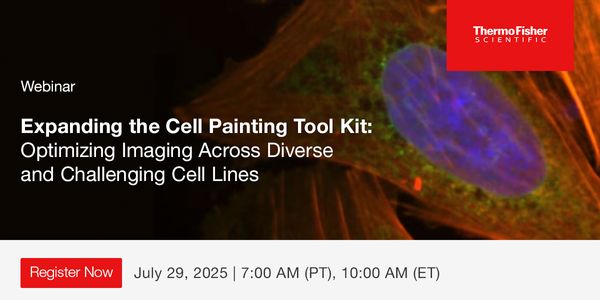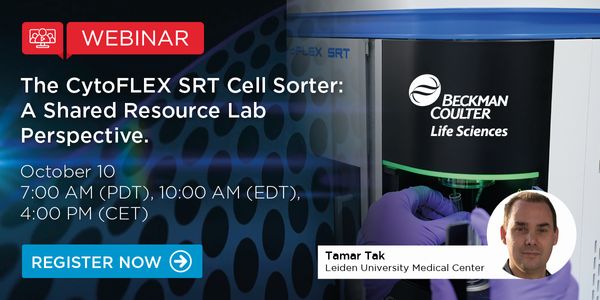Protocol
A protocol is a preset description of methods that can be followed to perform a scientific experiment. Clear, concise protocols provide specific steps and a list of materials needed to complete the experiment. Protocols ensure that data can be reproduced by other scientists and researchers.
-
October 16, 8am PT / 11am ET / 4pm BSTThis presentation will describe both common and specialized multiplex methods for RNA in situ hybridization (ISH) and immunohistochemical labeling of proteins (IHC). We initially used neuron...SEP 24, 2025 | 8:00 AMThe release of a recent EMA reflection paper, aligning with FDA and WHO positions, has resulted in a renewed focus on the central role of pharmacokinetic (PK) data, the primary status of ana...JUL 29, 2025 | 7:00 AMCell painting has established itself as a powerful tool for high content imaging, able to generate vast quantities of data in response to chemical perturbations. Over the past decade, cell p...MAY 20, 2025 | 10:00 AMIn this webinar, we expand on how the innovations of NovaSeq X are making multiomics a reality. We will highlight data from multi-project runs, massive single cell and CRISPR applications, a...NOV 20, 2024 | 8:00 AMThe Genome Diagnostics lab of the Human Genetics Dept. at Radboud UMC provides rapid whole exome sequencing since 2017, with a max turnaround time of 15 days (from sample to report). With th...Inborn errors of metabolism (IEMs) are rare, devastating disorders caused by pathogenic variants in genes encoding key metabolic enzymes, with the liver playing a critical role in over 140 I...
OCT 10, 2024 | 7:00 AM
The LUMC Flow Cytometry Core Facility is a Shared Resource Lab (SRL) that currently houses 24 instruments, including 9 conventional flow cytometers, 7 spectral flow cytometers, 3 mass cytome...
SEP 26, 2024 | 10:00 AM
Advances in spatial biology enable scientists to visualize multiplexed biomolecules across multiple 'omics technologies at single-cell resolution. However, all of these technologies requ...
SEP 19, 2024 | 10:00 AM
In the rapidly evolving field of oncology, precision medicine stands at the forefront of providing personalized patient care. Our upcoming webinar, "Transforming Oncology Diagnostics: I...
SEP 12, 2024 | 8:00 AM
Join this webinar to learn how the Bioscience Core Lab at KAUST has automated their PacBio Kinnex library prep workflow on Opentrons robots to facilitate high-throughput RNA sequencing. Ange...
Genetics may influence experience with cannabis and CBD. With increased access to legal cannabis and the research community expanding their focus on the medicinal uses of cannabinoids, more...
MAR 26, 2024 | 8:00 AM
DNA fragmentation is a critical step in preparing DNA libraries for short read-based protocols. The two primary methods are mechanical shearing (using acoustic technology like Covaris) and e...
MAR 20, 2024 | 8:00 AM
Luminex and Thermo Fisher Scientific are excited to feature two presentations highlighting the advanced features of the Invitrogen™ Luminex® xMAP® INTELLIFLEX™ DR-SE inst...
Speaker:
Sherry Dunbar, Ph.D., MBA
, Sigrun Badrnya, Ph.D.
Sponsored By: Thermo Fisher Scientific
How can labs increase their sample throughput and pipetting accuracy and reproducibility without investing in an expensive automated liquid handler? Electronic pipettes are a cost-effective...
Speaker:
Sandra Söderholm
, Joni Åke
FEB 15, 2024 | 8:00 AM
Macrophages can mediate phagocytosis of cancer cells and cytotoxic tumor killing, and engage in effective bidirectional interactions with components of the innate and adaptive immune system....
DEC 13, 2023 | 9:00 AM
The quest for digital excellence in today’s biotech research laboratories demands modern software acquisition, robust protection protocols, and a keen eye on evolving security requirem...
DEC 12, 2023 | 8:00 PM
Embryonic epicardium is crucial for normal heart morphogenesis. The tissue originates from the proepicardial organ, with cells migrating to form the outer mesothelial layer, giving rise to n...
Change in the lab is inevitable. Skilled labor shortages. Ongoing lab space consolidation and build-outs. Rapidly changing workflows and instrument layouts. Innovations in instrument technol...
NOV 14, 2023 | 8:00 AM
RNA-Seq remains a critical and robust methodology in understanding cellular and organismal changes associated with development and disease. Advances in automation have helped reduce the cost...
With the fast progress and deeper understanding of CAR-T cell therapy, finding a better solution other than lentivirus transduction is more requested, to overcome the functional limitation o...
OCT 30, 2023 | 8:00 PM
Description: Join this two-part webinar to learn how capillary electrophoresis (CE) complements sequencing technologies, such as next generation sequencing, that are being used by cancer res...
OCT 26, 2023 | 8:00 AM
Description: Join this two-part webinar to learn when capillary electrophoresis is an ideal choice relative to other various sequencing technologies – such as next generation sequencin...
OCT 24, 2023 | 10:00 AM
Dynamic changes in chromatin drive gene expression programs during cellular development and contribute to pathological changes underlying disease. To date, efforts to characterize chromatin...
OCT 05, 2023 | 1:00 AM
Organoids continue to gain traction in drug discovery efforts as they offer a more biologically relevant disease model than traditional approaches. But they aren't without challenges. Jo...
October 16, 8am PT / 11am ET / 4pm BST
This presentation will describe both common and specialized multiplex methods for RNA in situ hybridization (ISH) and immunohistochemical labeling of proteins (IHC). We initially used neuron...
SEP 24, 2025 | 8:00 AM
The release of a recent EMA reflection paper, aligning with FDA and WHO positions, has resulted in a renewed focus on the central role of pharmacokinetic (PK) data, the primary status of ana...
JUL 29, 2025 | 7:00 AM
Cell painting has established itself as a powerful tool for high content imaging, able to generate vast quantities of data in response to chemical perturbations. Over the past decade, cell p...
MAY 20, 2025 | 10:00 AM
In this webinar, we expand on how the innovations of NovaSeq X are making multiomics a reality. We will highlight data from multi-project runs, massive single cell and CRISPR applications, a...
NOV 20, 2024 | 8:00 AM
The Genome Diagnostics lab of the Human Genetics Dept. at Radboud UMC provides rapid whole exome sequencing since 2017, with a max turnaround time of 15 days (from sample to report). With th...
Inborn errors of metabolism (IEMs) are rare, devastating disorders caused by pathogenic variants in genes encoding key metabolic enzymes, with the liver playing a critical role in over 140 I...
OCT 10, 2024 | 7:00 AM
The LUMC Flow Cytometry Core Facility is a Shared Resource Lab (SRL) that currently houses 24 instruments, including 9 conventional flow cytometers, 7 spectral flow cytometers, 3 mass cytome...
SEP 26, 2024 | 10:00 AM
Advances in spatial biology enable scientists to visualize multiplexed biomolecules across multiple 'omics technologies at single-cell resolution. However, all of these technologies requ...
SEP 19, 2024 | 10:00 AM
In the rapidly evolving field of oncology, precision medicine stands at the forefront of providing personalized patient care. Our upcoming webinar, "Transforming Oncology Diagnostics: I...
SEP 12, 2024 | 8:00 AM
Join this webinar to learn how the Bioscience Core Lab at KAUST has automated their PacBio Kinnex library prep workflow on Opentrons robots to facilitate high-throughput RNA sequencing. Ange...
Genetics may influence experience with cannabis and CBD. With increased access to legal cannabis and the research community expanding their focus on the medicinal uses of cannabinoids, more...
MAR 26, 2024 | 8:00 AM
DNA fragmentation is a critical step in preparing DNA libraries for short read-based protocols. The two primary methods are mechanical shearing (using acoustic technology like Covaris) and e...
MAR 20, 2024 | 8:00 AM
Luminex and Thermo Fisher Scientific are excited to feature two presentations highlighting the advanced features of the Invitrogen™ Luminex® xMAP® INTELLIFLEX™ DR-SE inst...
Speaker:
Sherry Dunbar, Ph.D., MBA
, Sigrun Badrnya, Ph.D.
Sponsored By: Thermo Fisher Scientific
How can labs increase their sample throughput and pipetting accuracy and reproducibility without investing in an expensive automated liquid handler? Electronic pipettes are a cost-effective...
Speaker:
Sandra Söderholm
, Joni Åke
FEB 15, 2024 | 8:00 AM
Macrophages can mediate phagocytosis of cancer cells and cytotoxic tumor killing, and engage in effective bidirectional interactions with components of the innate and adaptive immune system....
DEC 13, 2023 | 9:00 AM
The quest for digital excellence in today’s biotech research laboratories demands modern software acquisition, robust protection protocols, and a keen eye on evolving security requirem...
DEC 12, 2023 | 8:00 PM
Embryonic epicardium is crucial for normal heart morphogenesis. The tissue originates from the proepicardial organ, with cells migrating to form the outer mesothelial layer, giving rise to n...
Change in the lab is inevitable. Skilled labor shortages. Ongoing lab space consolidation and build-outs. Rapidly changing workflows and instrument layouts. Innovations in instrument technol...
NOV 14, 2023 | 8:00 AM
RNA-Seq remains a critical and robust methodology in understanding cellular and organismal changes associated with development and disease. Advances in automation have helped reduce the cost...
With the fast progress and deeper understanding of CAR-T cell therapy, finding a better solution other than lentivirus transduction is more requested, to overcome the functional limitation o...
























